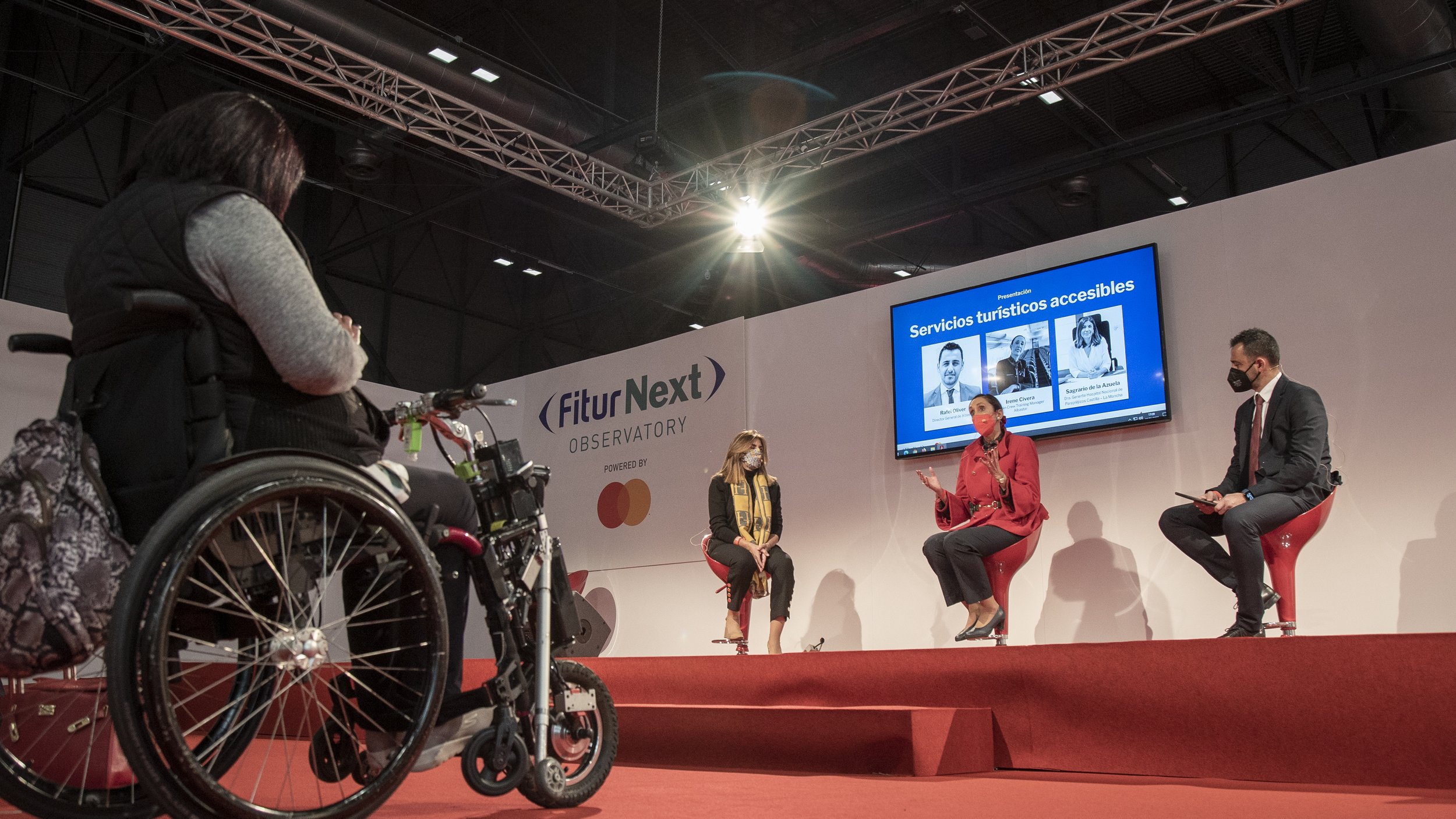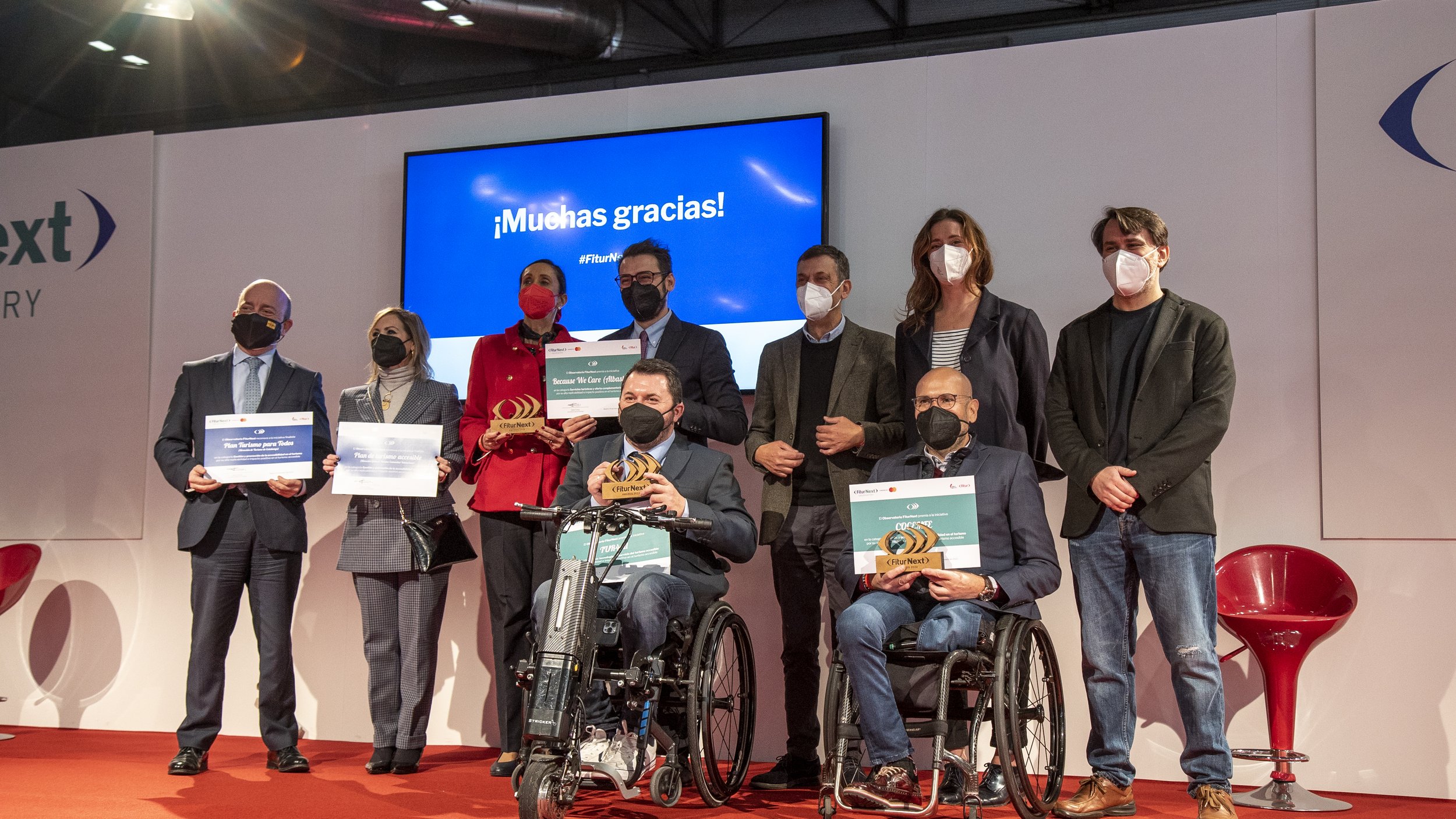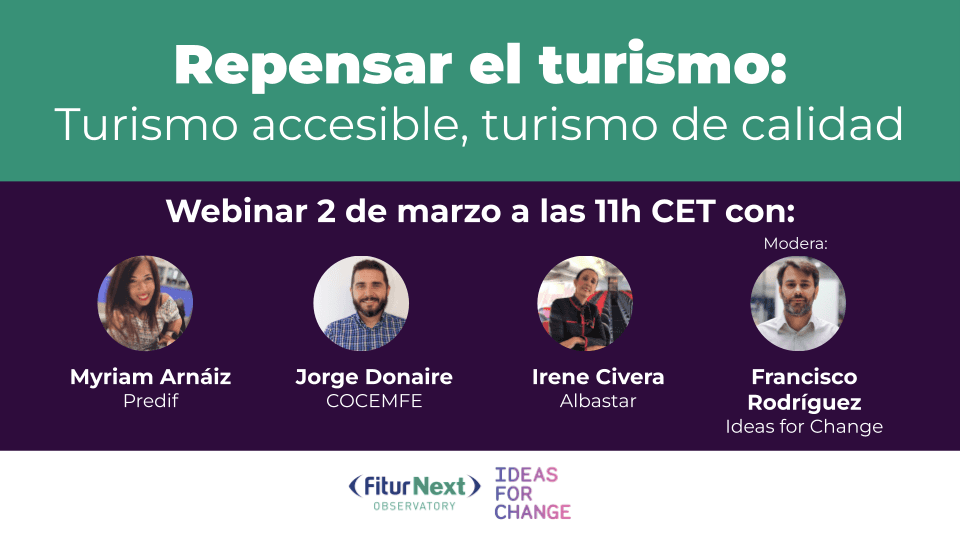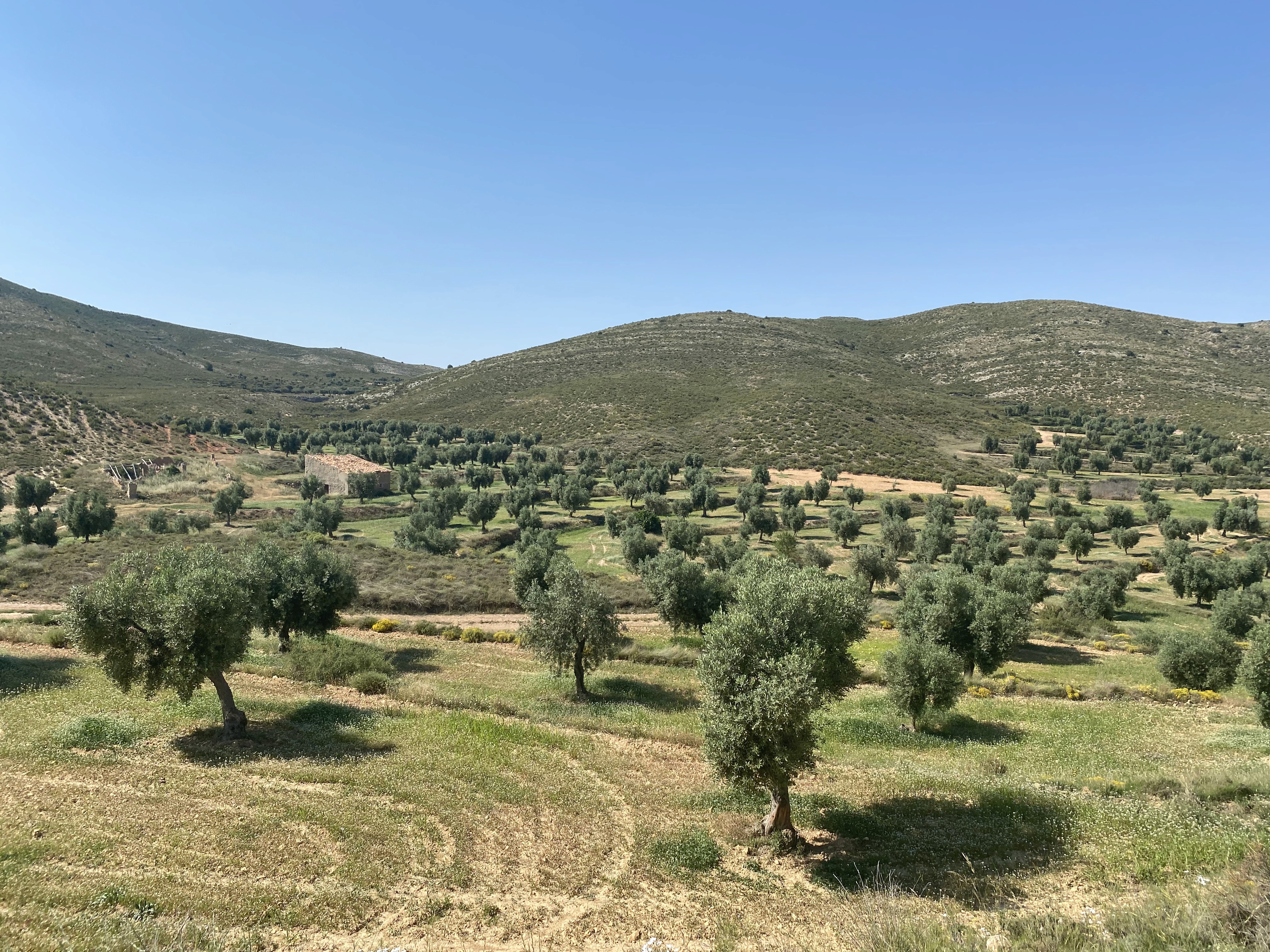Regenerative tourism
Regenerative tourism
Fiturnext 2022: Towards a more accessible society
Fiturnext 2022: Towards a more accessible society
24 de febrero de 2022


By Pako Rodríguez, consultant specialized in tourism. (Original publication in Spanish)
After the closure of FiturNext 2022, it is time to reflect on all that has been learned during these months, both through the initial interviews with sector experts and the analysis of initiatives, as well as the conversations held with them during the last months of 2021 and the talks that took place during the days of Fitur. Among these learnings, the following stand out:
First lesson: accessibility goes beyond the removal of barriers, the aim is a “tourism for all”. Tourism for all people, based on the concept of Universal Design, understood as “the design of products and environments suited for use by the greatest number of people without the need for adaptations or specialized design,” seeks to create tourist destinations whose spaces are not merely adapted for tourists with disabilities, but can be enjoyed on equal terms by all travelers, whether they have a disability or not.
This should also be the case because tourism, among other factors, plays a significant role in achieving a more accessible society. Furthermore, inclusion, as indicated by the UNWTO, is a very relevant aspect for the reactivation of tourism activity. That is to say, in addition to being a matter of social justice, it is profitable for the supply.
Second lesson: tourist accessibility is limited by the least accessible link in the value chain. In this case, the creation of an ecosystem that keeps all links in the chain strong is essential to overcome those limits. In order to achieve comprehensive accessibility, from end to end, the involvement and collaboration among all the elements that make up this chain providing value to accessible tourism is necessary. The search for information, the booking of the trip, the overall enjoyment, the return, and the accommodation offer are some of the elements included in the chain.
To try to address a good part of this, in the report “Towards a More Accessible Tourism” we present our research, both regarding accessible tourism and replicability, and delve into the challenge of accessibility by highlighting the winning and finalist initiatives in greater depth.
Let us remember what these initiatives have been and the positive impact of their projects.
The three winners
TUR4all is a collaborative digital platform, launched by PREDIF (State Representative Platform for People with Physical Disabilities), which promotes accessible resources to raise awareness of offers and destinations available to all people. The content is rated by the users themselves, and the application has more than 4,600 inclusive tourist resources.

Albastar is an airline that focuses on pilgrimage routes, allowing comfortable travel on this means of transport for people with any type of disability.
COCEMFE is a non-profit organization that, among other actions, organizes accessible trips for people with disabilities. Its proposal is beneficial for both users, as it covers the planning of activities, transportation, and accommodation at the destination, and for organizations and public administrations by assisting them with training and their accessibility plans.
And the finalists
Equalitas Vitae, which contributes to accessibility through consulting services, training, and content generation through its blog Silleros Viajeros.
Travelers without Limits, which increases the visibility of accessible destinations and activities through first-person videos made by its promoter.
Feeling the High Tajo, which organizes activities and ecotourism packages with an accessible focus.
Can Morei, which offers adapted rural accommodation for people with disabilities.
Borja with all senses, which seeks to promote accessible cultural activity within its municipality while turning the destination into a pioneer in accessibility in Aragon.
Catalan Tourism Agency, which has published the guide Tourism for All and carries out training and awareness-raising actions for the tourism sector to properly adapt products and services.
Dominican Access, which promotes accessible tourism and the need for a more inclusive society in the Dominican Republic.
Turisme Comunitat Valenciana, through its accessible tourism program disseminates tools and guides for the community's tourist services to apply them to their offer and make the destination accessible.
On Wheels App, which allows users to find accessible resources in various cities through its collaborative platform.

Just as it happens with the challenges of previous editions of Fiturnext, accessibility is such an important issue that it must always be present. Therefore, on March 2nd, we are organizing a webinar with the participation of the winning initiatives of the Fiturnext 2022 challenge, where we will discuss the report “Towards a More Accessible Tourism” and present the next Fiturnext 2023 challenge, focused on how tourism can contribute to regenerating the natural environment.
By Pako Rodríguez, consultant specialized in tourism. (Original publication in Spanish)
After the closure of FiturNext 2022, it is time to reflect on all that has been learned during these months, both through the initial interviews with sector experts and the analysis of initiatives, as well as the conversations held with them during the last months of 2021 and the talks that took place during the days of Fitur. Among these learnings, the following stand out:
First lesson: accessibility goes beyond the removal of barriers, the aim is a “tourism for all”. Tourism for all people, based on the concept of Universal Design, understood as “the design of products and environments suited for use by the greatest number of people without the need for adaptations or specialized design,” seeks to create tourist destinations whose spaces are not merely adapted for tourists with disabilities, but can be enjoyed on equal terms by all travelers, whether they have a disability or not.
This should also be the case because tourism, among other factors, plays a significant role in achieving a more accessible society. Furthermore, inclusion, as indicated by the UNWTO, is a very relevant aspect for the reactivation of tourism activity. That is to say, in addition to being a matter of social justice, it is profitable for the supply.
Second lesson: tourist accessibility is limited by the least accessible link in the value chain. In this case, the creation of an ecosystem that keeps all links in the chain strong is essential to overcome those limits. In order to achieve comprehensive accessibility, from end to end, the involvement and collaboration among all the elements that make up this chain providing value to accessible tourism is necessary. The search for information, the booking of the trip, the overall enjoyment, the return, and the accommodation offer are some of the elements included in the chain.
To try to address a good part of this, in the report “Towards a More Accessible Tourism” we present our research, both regarding accessible tourism and replicability, and delve into the challenge of accessibility by highlighting the winning and finalist initiatives in greater depth.
Let us remember what these initiatives have been and the positive impact of their projects.
The three winners
TUR4all is a collaborative digital platform, launched by PREDIF (State Representative Platform for People with Physical Disabilities), which promotes accessible resources to raise awareness of offers and destinations available to all people. The content is rated by the users themselves, and the application has more than 4,600 inclusive tourist resources.

Albastar is an airline that focuses on pilgrimage routes, allowing comfortable travel on this means of transport for people with any type of disability.
COCEMFE is a non-profit organization that, among other actions, organizes accessible trips for people with disabilities. Its proposal is beneficial for both users, as it covers the planning of activities, transportation, and accommodation at the destination, and for organizations and public administrations by assisting them with training and their accessibility plans.
And the finalists
Equalitas Vitae, which contributes to accessibility through consulting services, training, and content generation through its blog Silleros Viajeros.
Travelers without Limits, which increases the visibility of accessible destinations and activities through first-person videos made by its promoter.
Feeling the High Tajo, which organizes activities and ecotourism packages with an accessible focus.
Can Morei, which offers adapted rural accommodation for people with disabilities.
Borja with all senses, which seeks to promote accessible cultural activity within its municipality while turning the destination into a pioneer in accessibility in Aragon.
Catalan Tourism Agency, which has published the guide Tourism for All and carries out training and awareness-raising actions for the tourism sector to properly adapt products and services.
Dominican Access, which promotes accessible tourism and the need for a more inclusive society in the Dominican Republic.
Turisme Comunitat Valenciana, through its accessible tourism program disseminates tools and guides for the community's tourist services to apply them to their offer and make the destination accessible.
On Wheels App, which allows users to find accessible resources in various cities through its collaborative platform.

Just as it happens with the challenges of previous editions of Fiturnext, accessibility is such an important issue that it must always be present. Therefore, on March 2nd, we are organizing a webinar with the participation of the winning initiatives of the Fiturnext 2022 challenge, where we will discuss the report “Towards a More Accessible Tourism” and present the next Fiturnext 2023 challenge, focused on how tourism can contribute to regenerating the natural environment.


